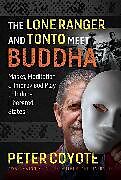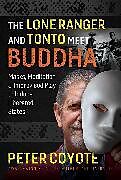The Lone Ranger and Tonto Meet Buddha
Einband:
Kartonierter Einband
EAN:
9781644113561
Untertitel:
Masks, Meditation, and Improvised Play to Induce Liberated States
Genre:
Spiritualität
Autor:
Peter Coyote
Herausgeber:
Simon & Schuster N.Y.
Anzahl Seiten:
192
Erscheinungsdatum:
28.04.2022
ISBN:
978-1-64411-356-1
“In this wild and wonderful book, Coyote weaves together his practices of Zen Buddhism and meditation with his experiences in theater and film, and as a well-known narrator of documentary drama. In the process, he teaches us how to put on and take off all our masks. The outcome is a bunch of fresh new techniques of exploring and gaining freedom from the suffering of a separate self. I encourage you to go on this spiritual journey with Coyote. It is a path true to the great tradition of ‘crazy wisdom.’ And this is the last self-help book you’ll ever need.”
Autorentext
Peter Coyote is an award-winning actor, author, director, screenwriter, and narrator who has worked with some of the world’s most distinguished filmmakers. Recognized for his narration work, he narrated the PBS series The Pacific Century, winning an Emmy award, as well as eight Ken Burns documentaries, including The Roosevelts, for which he won a second Emmy. In 2011 he was ordained as a Zen Buddhist priest and in 2015 received "transmission" from his teacher, making him an independent Zen teacher. The author of several books, he lives in northern California.
Klappentext
Reveals how to use masks, meditation, and improvisation to free yourself from overthinking, self-doubt, and fixed ideas of who you think you are
Leseprobe
From Chapter 3. Working with Masks
Without some training, simply placing a mask over your face and looking in a mirror may paralyze rather than liberate your imagination. Occasionally, the experience of “disappearing” proves unsettling to some. One night, a seasoned Zen student, was visiting and insisted on trying on a mask. Despite having done no warm-ups or preparations, I was curious to see what might occur and agreed.
When he encountered his masked reflection, he became emotionally frozen. He could describe what he felt arising from the mirror, but some emotional detachment prevented him from expressing his feelings as behavior. He could not integrate new impulses into his body or psyche in any way, nor could he express any intention. The “self” is a strict master and has to be either exhausted or seduced to let go.
Old psychic wounds and impressions, once too important to forget, are deeply buried in our muscles and ligaments. Like landmines abandoned after a war, they remain hidden, their potential for damage undiminished by time. A psychiatrist once told me, “In the unconscious, it’s always this morning,” meaning that the unconscious has no sense of time. All its memories are pungent and immediate. However, even in the extreme case of my Zen friend, wearing a mask highlighted a path by identifying a problem he could not deny. Suffice it to say, since then, I have never short-changed warm-up games and exercises. Consequently, I urge students (and readers) to be patient during descriptions of exercises that appear at first blush to have little or nothing to do with egoless states.
Pointless or silly as they may appear, these games are not addressed to the intellect, but to the body and Big Mind, the surrounding vastness in which all ideas about oneself float. Enlightenment is not something we think about, but express in each moment. Each exercise is designed to alter some sense of the body’s feelings about “normal” by coaxing you to imagine, move, stand, behave, and project yourself in ways which appear to you as counter-intuitive and definitely not-you. These simple games expose the borders and “soften” the sense of self by encouraging you to explore attitudes, feelings, physical postures, intentions, and behavior beyond the safety of your known persona. If, for instance, you begin to move in a way that does not feel like you, it’s possible to become fully aware of that resistance, identify it, and study it clearly rather than dismiss it or flee its influence. Why is it not you? What’s wrong with it, other than your discomfort?
Richard Baker-Roshi, the Abbot at San Francisco Zen Center when I began my practice there, once asked me to attend a function with him. I knew I would encounter people there I did not like and so I demurred, saying that I would be “uncomfortable” in that situation. His immediate response was, “What’s wrong with being uncomfortable?” His answer indicated a door for me to consider. “Who” had made that decision, and why had my discomfort been suddenly elevated to the highest priority?
If your normal posture and social strategy represents a desire “not to be noticed,” being compelled to behave boldly or aggressively will awaken a host of resistances, worries, and previously rejected feelings. If you fear that spontaneous responses might expose you as foolish, reveal unconscious baggage, or that being out-of-control frightens you, these exercises will have revelatory value for you. They may initially feel off-task or trivial, but they’re extremely practical for highlighting aspects of the self we normally consign to invisibility.
The more familiar you are with your habits and partialities, the more easily you can alter them. These exercises address the unconscious directly, feeding it new information and strange associations which nudge it off balance and onto high alert. It is that high-alert state seeking normalcy, which, when presented with the unknown mask, scrambles to assemble a new coherent personality that matches associations with the face in the mirror.
In each class, after a morning’s exercises and games, the masks are introduced. The masks are neutral masks which do not express any particular emotion. However, there is a definite quality to their neutrality, a tabula rasa which allows maximal space for the wearer (and audience) to “read-in” qualities. This blankness makes them mutable, so that each person’s body and head-shape alters the mask’s emotional tone. A mask which appears docile and defeated on one person, appears edgy and sullen on another, seductive or provocative on a third. It is their “emptiness” of qualities which facilitates these transformations. Some masks “work” and others do not and it’s hard to determine which will work at first look. One of my favorite masks is a stamped, nearly featureless plastic face that cost a dollar. It has enormous eye holes, but somehow always transforms the wearer by bringing forth a very clear personality.
For Buddhists, it is the “emptiness” (formlessness) at the root of all things which accounts for the worlds’ infinite variety of forms. If emptiness had any fixed qualities there would be things it could not express. In mask-work, that emptiness is the vacuum the mind abhors and rushes to fill in with data.
Class always opens with some minutes of meditation. After that, the best part of the morning session is dedicated to exercises and games. When it feels right, we meet the masks. Students are called up in groups of three to five. They are instructed to turn their backs to the class, and I stand before them holding an 18-inch square mirror close to their faces. As they slip on a mask and arrange their hair over its edges I encourage them to alter the angle of their head--tilting one way or another, looking up from under their brows or down their nose, widening or narrowing their eyes, regarding the mirror obliquely--until something “clicks.” When that occurs, they nod to indicate that they’ve “got it.” I remind them that if they begin to lose the new identity, simply call out “Mirror” and I’ll return so the…

Leider konnten wir für diesen Artikel keine Preise ermitteln ...
billigbuch.ch sucht jetzt für Sie die besten Angebote ...
Die aktuellen Verkaufspreise von 6 Onlineshops werden in Realtime abgefragt.
Sie können das gewünschte Produkt anschliessend direkt beim Anbieter Ihrer Wahl bestellen.
Loading...
Die aktuellen Verkaufspreise von 6 Onlineshops werden in Realtime abgefragt.
Sie können das gewünschte Produkt anschliessend direkt beim Anbieter Ihrer Wahl bestellen.
| # | Onlineshop | Preis CHF | Versand CHF | Total CHF | ||
|---|---|---|---|---|---|---|
| 1 | Seller | 0.00 | 0.00 | 0.00 |
